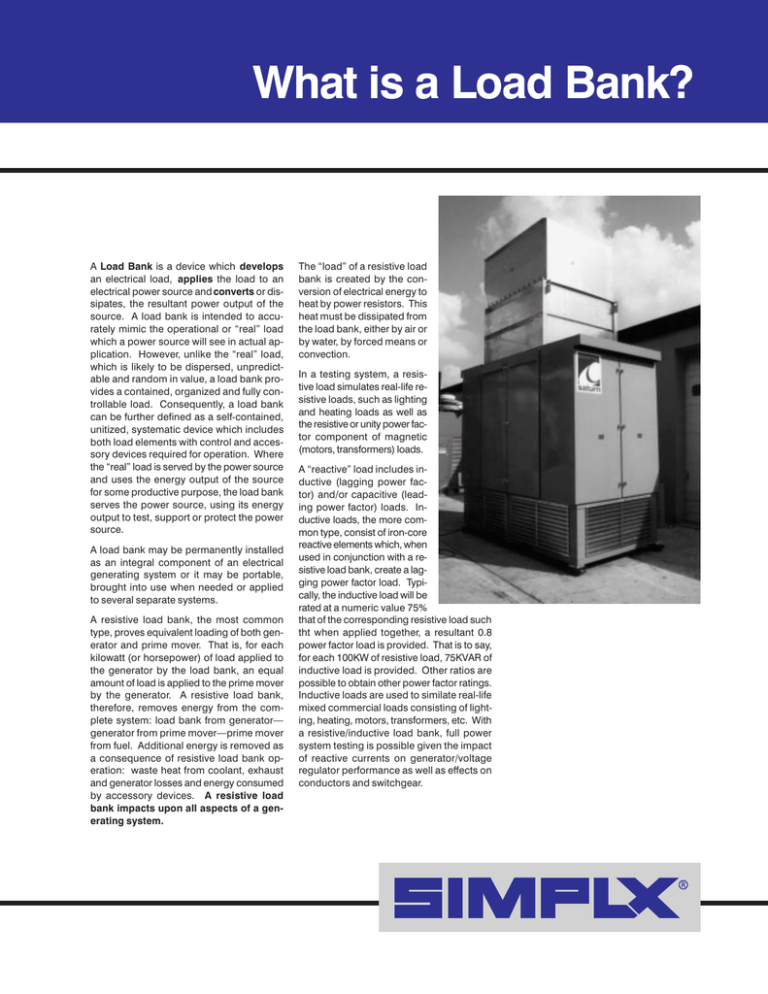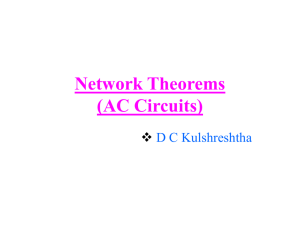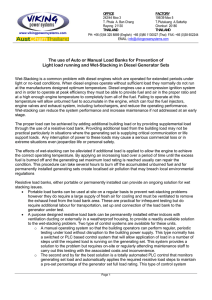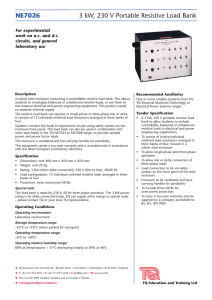
What is a Load Bank?
Portable Load Bank
A Load Bank is a device which develops
an electrical load, applies the load to an
electrical power source and converts or dissipates, the resultant power output of the
source. A load bank is intended to accurately mimic the operational or “real” load
which a power source will see in actual application. However, unlike the “real” load,
which is likely to be dispersed, unpredictable and random in value, a load bank provides a contained, organized and fully controllable load. Consequently, a load bank
can be further defined as a self-contained,
unitized, systematic device which includes
both load elements with control and accessory devices required for operation. Where
the “real” load is served by the power source
and uses the energy output of the source
for some productive purpose, the load bank
serves the power source, using its energy
output to test, support or protect the power
source.
A load bank may be permanently installed
as an integral component of an electrical
generating system or it may be portable,
brought into use when needed or applied
to several separate systems.
A resistive load bank, the most common
type, proves equivalent loading of both generator and prime mover. That is, for each
kilowatt (or horsepower) of load applied to
the generator by the load bank, an equal
amount of load is applied to the prime mover
by the generator. A resistive load bank,
therefore, removes energy from the complete system: load bank from generator—
generator from prime mover—prime mover
from fuel. Additional energy is removed as
a consequence of resistive load bank operation: waste heat from coolant, exhaust
and generator losses and energy consumed
by accessory devices. A resistive load
bank impacts upon all aspects of a generating system.
The “load” of a resistive load
bank is created by the conversion of electrical energy to
heat by power resistors. This
heat must be dissipated from
the load bank, either by air or
by water, by forced means or
convection.
In a testing system, a resistive load simulates real-life resistive loads, such as lighting
and heating loads as well as
the resistive or unity power factor component of magnetic
(motors, transformers) loads.
A “reactive” load includes inductive (lagging power factor) and/or capacitive (leading power factor) loads. Inductive loads, the more common type, consist of iron-core
reactive elements which, when
used in conjunction with a resistive load bank, create a lagging power factor load. Typically, the inductive load will be
rated at a numeric value 75%
that of the corresponding resistive load such
tht when applied together, a resultant 0.8
power factor load is provided. That is to say,
for each 100KW of resistive load, 75KVAR of
inductive load is provided. Other ratios are
possible to obtain other power factor ratings.
Inductive loads are used to similate real-life
mixed commercial loads consisting of lighting, heating, motors, transformers, etc. With
a resistive/inductive load bank, full power
system testing is possible given the impact
of reactive currents on generator/voltage
regulator performance as well as effects on
conductors and switchgear.
What is a Load Bank?
A capacitive load bank is similar to a reactive
load bank in rating and purpose, except leading power factor loads are created. These loads
simulate certain electronic or non-linear loads
typical of telecommunications, computer or UPS
industries.
Simplex manufactures a broad line of load
banks, including:
• Stationary, resistive engine radiator airflow
cooled (LBD Series)
• Stationary, resistive, resistive/reactive, freestanding forced air cooled (LBS Series)
• Stationary, resistive, freestanding, watercooled (LBW Series)
• Portable, resistive, resistive/reactive, forced
air cooled.
Applications
Automatic
• Generator exercise, control from remote control contacts
• Automatic exercise/test via programmable
microprocessor control
• Automatic load leveling/load regulation to
maintain preset load on generator by sensing of total load and automatic addition or
subtraction of load bank component.
Features
Variable power factor loading is possible with a resistive/reactive load bank by adjusting the ratio of resistive to inductive load.
• Reverse power/regenerative power protection of generator by sensing power direction
and magnitude and automatic addition of
load bank component to act as a power sink.
Manual
• Generator exercise and testing via local or
remote manual control
• Minimum loading of generators
Malfunction Detection
Cooling System
Simplex Load Banks are equipped with a malfunction detection system which provides automatic load disconnect and alarm on sensing of
an abnormal operating condition. The system
includes the following:
Simplex Load Banks are equipped with an integral forced air cooling system consisting of the
following:
• Cooling air intake temperature switch, set at
120°F, to sense recirculation of load bank hot
exhaust air or an ambient temperature above
the rating of the load bank
• Cooling air exhaust temperature switch, set
75°F above maximum rise at maximum ambient, to sense restricted cooling airflow, recirculating air, loss of airflow.
• Air pressure switch to sense for positive cooling airflow
• Motor drive propeller fan
• Fan blade, shrouded for high efficiency
• Motor control contactor
• Motor circuit breaker
• Fan motors normally operate at load bank
line voltage
• Motors for outdoor load banks are totally
enclosed
• Motors for indoor load banks are open-dripproof
• Overvoltage, dual/multi-voltage load banks
• Automatic load disconnect/lockout circuit
• Remote alarm contacts
Simplex, Inc. • 1139 North MacArthur Boulevard • Springfield, Illinois 62702 • 217-525-6995 • 24 hr. 217-528-3130 • Fax 217-525-7984
http://www.thomasregister.com/simplexinc • 4A82845 © 1997 • All Rights Reserved • Design subject to change without notice • Printed in the USA
What is a Load Bank?
Specifications
• Alloy: FeCrAl
• Maximum continuous temperature
rating: 1920°F
• Maximum operating temperature as
applied in Load Bank: 1080° F
Powr-Web
Resistive
Load
Element
• Cool down time from operating to
ambient temperature is 10 seconds.
Description
The Simplex “Powr-Web” load resistor is an advanced design, air-cooled power resistor specifically designed for application to load bank
systems. The “Powr-Web” is conservatively operated at half the maximum temperature rating
of the alloy and features a short-circuit-safe design based on continuous mechanical support
of the resistor by high temperature, ceramic clad
stainless steel rods. The “Power Webs” are assembled into discrete trays which are assembled
in a vertical “stack.” Each tray in the “stack” is
independently serviceable without disturbing adjacent trays.
Construction
• Precision calibrated to
specific ohmic value
• Welded lugs each end
• All load elements are
continuously supported by
vibration resistant, ceramic
clad, stainless steel
throughrods.
Ratings
• 3333W at 120V
• 4170W at 139V
• 8333 watt 240/480V
• 16,777 watt at 480V
The Simplex inductive load banks consist
of discrete iron-core load elements. These
are non-saturable, air gap calibrated, air
cooled devices and are field replaceable.
Standard elements have a temperature
sensor embedded in the windings to detect element overheating and through the
module malfunction detection system, disconnect the load elements and activate an
alarm. Standard elements are varnish
coated; epoxy coatings are available for
severe environments.
Inductive
Load
Elements
Specifications
Tolerance:
5%
Maximum Harmonic Distortion:
1%
Power Factor:
.05
Insulation:
220°C
Cooling:
Air
Simplex, Inc. • 1139 North MacArthur Boulevard • Springfield, Illinois 62702 • 217-525-6995 • 24 hr. 217-528-3130 • Fax 217-525-7984
http://www.thomasregister.com/simplexinc • 4A82845 © 1997 • All Rights Reserved • Design subject to change without notice • Printed in the USA
What is a Load Bank?
Design
Profile
APPLICATIONS
Engine Generators, Battery Systems, UPS Systems, Inverters, Ground Power Units, Auxiliary
Power Units, Aircraft Power Generators, Wind Generators, and Hydro Generators are used to
test, prove and maintain AC or DC generators and power supplies
PURPOSE
Test - Precision testing instrument which applies a discrete, selectable electrical load to a power
generator and measures the response of the generator to the applied load. Measurements of
response stability and endurance can be made and corresponding calibrations and adjustment
can be effected while a precise load is maintained on the power source
Exercise - Exercise load banks assure the long term reliability and readiness of standby generators by providing a means for routine maintenance exercise of the generator under load.
Exercise load banks eliminate the detrimental effects of unloaded operation of diesel engine
contractual performance specifications
Demonstration - A sophisticated engineering tool for demonstrating product performance and
capability to buyers and users and for fulfilling contractual performance specifications
TYPE
Resistive - Dissipates energy output of generator and prime mover as heat. Unity power
factor loading of generator. KVA load applied to generator equals KW load applied to prime
mover. Provides equivalent of commercial lighting, heating loads
Inductive - Used in parallel with resistive load bank to obtain lagging power factor, increase
KVA load on generator; does not increase KW load on prime mover. Provides equivalent of
commercial motor, transformer loads
Capacitive - Used in parallel with resistive load bank to obtain leading power factor, increases
KVA load on generator; does not increase KW load on prime mover. Provides equivalent of
commercial electronic, fluorescent light loads
CAPACITY
Single Block - Entire capacity of load bank applied, on/off, in one step increment
Multiple Steps - Load bank capacity is divided into discrete increments for application in steps;
defined in terms of load step resolution, which is the smallest step increment of load control.
Steps can be coarse (50%, 33%, 25%) or fine (5KW, 1KW)
Single Voltage - Designed for a specific voltage, typical of exercise load banks to 15KV.
Multiple Voltage - Capable of dual or quad voltages. Typical of test systems. (Typical voltages—60HZ: 120/240, 208-240, 416-480; 50HZ: 190-220, 380-420; DC: 12-60, 125, 250) to
15KV.
Single Frequency - Designed for a specific frequency
Multiple Frequency - Capable of multiple frequency or AC/DC operation (Typical frequencies: 50-60-400HZ, DC)
COOLING
Natural Convection Air - 20 KW Maximum
Integral Fan - Cooling fan included in load bank; up to 3000 KW.
Radiator Airflow - Load bank installed in radiator fan airflow; up to 1000 KW
Water - Cooling via heat transfer to water flow; water does not conduct electrical current. Open
flow using commercial/natural water or closed loop using heat exchanger up to 1200 KW.
ENCLOSURE
Portable - For factory, shop, field use, self-contained
Stationary - For permanent installation at a specific site
Duct Mounting - For permanent installation in radiator airflow
Indoor - NEMA 1 enclosures
Outdoor - NEMA 3R enclosures
CONTROL
Local - Control panel self-contained in load bank
Remote - Control panel for remote operation
Automatic - Wide variety of auto control available including auto on-off, auto load regulation,
KW or reverse power response, computer control
CONNECTION
Cable Set - Connection cable included with load bank. Typical of portable units
Terminal Block - Power terminals for connection of building cables. Typical of stationary and
duct mounted units.
Plugs - To match commercial wiring devices, aircraft plugs, MIL-SPEC plugs, cam-lock connections.
FEATURES
Short Circuit Protection - Load element branch circuit fuse or circuit breaker protection
System Protection - Protected against running failures (fan fail, overtemp, overvolt, etc.)
Control - Self-contained load control devices (contactors, relays, circuit breakers)
Handling - Forklift channels, lifting eyes, casters on portable units.
Instrumentation - Full instrumentation available: analog or digital; data acquisition systems
Options - Many options available
Simplex will also custom design load banks to your special requirements.
Use the general specifications as a guide.
Simplex, Inc. • 1139 North MacArthur Boulevard • Springfield, Illinois 62702 • 217-525-6995 • 24 hr. 217-528-3130 • Fax 217-525-7984
http://www.thomasregister.com/simplexinc • 4A82845 © 1997 • All Rights Reserved • Design subject to change without notice • Printed in the USA






